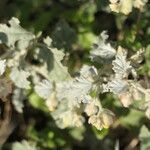Suffrutex, erect, bushy, up to about 60 cm tall but often smaller, densely tomentose on most parts with short-rayed stellate hairs radiating from a central scale, interspersed with usually longer rayed, grouped hairs on a scale which becomes detached and often with very minute, scattered, black-headed, gland-tipped, hairs; branches or branchlets often zig-zag. Stipules in upper parts of plant lanceolate to ovate-lanceolate, 6-10 mm long, 2-4 mm broad just above base, lower stipules smaller, 3-4 mm long, about 1 mm broad above base. Leaves petiolate; blade usually broadly ovate to suborbicular with a truncate or broadly cuneate base, varying in size even on same plant, from about 8 mm long and 7 mm broad just above base, to about 35 mm long and 30 mm broad (lower-most up to 45 mm long), some leaves in upper parts of plant narrowly ovate-lanceolate and cuneate in lower half, stellate-tomentose on both surfaces, strongly corrugated at least at margins, nerves prominent beneath obscurely 3-lobed as well as crenate at margin; petiole tomentose, 4-26 mm long. Inflorescence of 1 or more, 1-3-flowered cymes in axils of upper leaves and crowded at apices of ultimate branchlets or sometimes forming long, leafy, racemose cymes; mature flowers on herbarium specimens 6-10 mm long; bracts and bracteoles subulate to narrowly lanceolate, 2-10 mm long, up to 3 mm broad near base; peduncles and pedicels short, mostly under mm long. Calyx not or subinflated with age, urceolate to campanulate, narrowed at mouth when young, lobed almost to middle, stellate-tomentose with short hairs, often mixed with long hairs, in mature flowers on herbarium specimens measuring from 4.5 mm to 9 mm long. Petals orange to lemon-coloured, about 6 to 9 mm long, more or less oblong in upper third, then narrowed into a waist with infolded margins and produced below into a claw, stellate-pubescent in parts especially in waist. Stamens about 4 mm long, with broadly obovate to suborbicular hyaline filaments minutely pubescent on shoulders, anthers about 2.5 mm long, overlapping filament at base, ciliate. Ovary 5-lobed, about 2.5 mm long, stellate-tomentose, hairs long at apex; stipe about 1 mm long; styles cohering, about 5 mm long, minutely capitate at apex, exserted from flowers. Capsule enveloped by long-persistent calyx and corolla, about 5 mm long, stellate-tomentose with hairs short and long, 5-umbonate at the apex. Seeds reniform, corrugated, 1.5 x 1 mm, minutely papillose.
More
Erect suffrutex, bushy, 0.10-0.75 m high; densely tomentose with short-and long-rayed stellate hairs radiating from central scale, minute black-headed, gland-tipped hairs scattered in tomentum. Leaves petiolate, ± suborbicular, base broadly cuneate, apex rounded, margins crisped as well as crenate, nerves prominent beneath; stellate-tomentose on both surfaces. Stipules ovate-lanceolate in upper parts of plant. Inflorescences of 1-3-flowered cymes in axils of upper leaves or forming racemose cymes; peduncles up to 5 mm long; pedicels tomentose. Flowers 10 mm long, orange-lemon-coloured. Calyx subinflated, campanulate, 5-lobed almost to middle, sinuses wide; stellate-tomentose mostly with short hairs. Petals oblong in upper 1/3, produced into claw. Flowering time Nov.? Fruit a capsule hidden by persistent petals.
Perennial herb, up to 0.6 m high. Stems erect, branches and branchlets often zigzag; densely tomentose. Leaves petiolate; blade broadly ovate to suborbicular, base truncate to broadly cuneate, margins obscurely 3-lobed, crenate, strongly corrugated, both surfaces stellate-tomentose, lower surface with veins prominent. Flowers: in 1-3-flowered cymes in axils of upper leaves; calyx 5-6 mm long, urceolate to campanulate, lobed almost to middle; petals 5-6 mm long, oblong in upper third, then narrowed into a waist with infolded margins and produced below into a claw, stellate-pubescent in parts, especially in waist, orange to lemon-coloured; Sep.-Mar.
Erect, bushy shrub, up to ± 600 mm tall. Leaves broadly ovate to suborbicular, truncate or cuneate at base, stellate-tomentose, strongly corrugated towards margins, nerves prominent beneath. Flowers 1-3 in axils of upper leaves and at branch tips, orange to lemon yellow.

